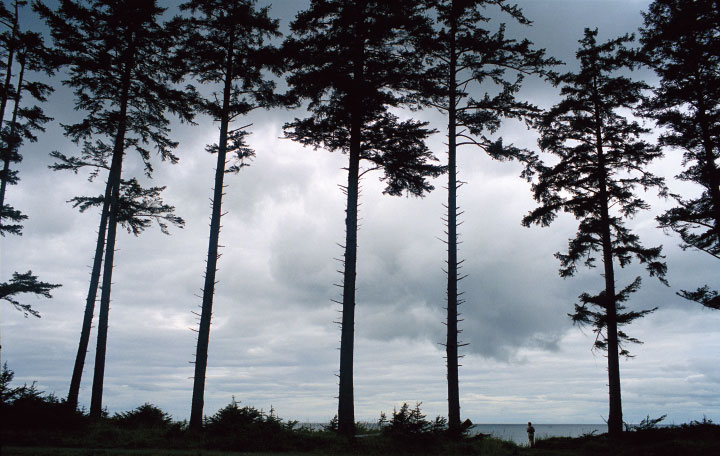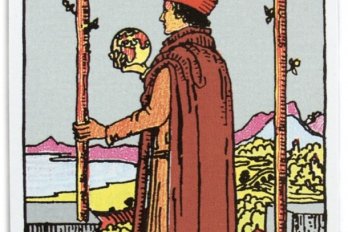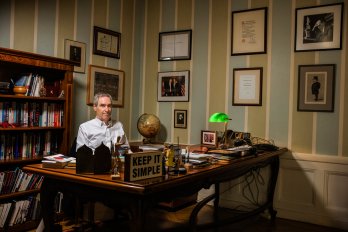The doves are gone. I heard them calling out of the cold dawn and came to the deck in my robe. Like many Canadian homes, my house is in the middle of an old clear-cut. I sit on the deck and think of the wild birds. The shadows appear as the sun breaks through the clouds and I am taken back to my boyhood inside an image of light. I am standing in snow and staring out at a lake where a moose is crossing on the ice. The moose is huge in the empty world of winter. Surrounding her is the great forest I wandered in when I was young. The moose throws up splinters of snow as she runs. The ice glints in prisms, bits of light caught for a moment in the sun, and then she is gone into the trees on the farther shore. Once again the forest surrounds her. What remains is the wind. As I sit on my deck, the wind begins to fill in the passage the moose made, snow sifting upon snow. In an hour, it is as if she had never been there, and I rise and go back to my desk.
When I was a boy, the wild world was my great love. The bush began a mile or two from the edge of town and, clad in cotton jeans, a T-shirt, and torn running shoes, I wandered into the backcountry. Almost always alone, I carried across my shoulders the packsack my father brought back from the war. In it were usually a couple of apples and two peanut butter sandwiches made with my mother’s fresh bread, along with a coil of fishing line with a few hooks and some worms I had dug up from the garden and wrapped in wax paper. I had my father’s army water bottle hooked to my belt, and to complete the outfit, a slingshot when I was small, then a BB gun, and later, when I was thirteen, a .22 Cooey rifle.
In the seasons of the forest I was a white hunter, a boy playing at being a man, modelling myself on the books I had read: Ernest Thompson Seton’s Wild Animals I Have Known or R. M. Ballantyne’s The Gorilla Hunters. Movie actors helped: Stewart Granger heroic in Africa or the endless cowboy movies with Tom Mix, Hopalong Cassidy, Roy Rogers, and Lash LaRue sitting alone around campfires staring off at the stars, trusty horse and dog beside them. Equally alone, I sat around my own fires beside lakes, creeks, and isolated meadows staring up at what I knew were the same stars. Sometimes, coming home, I would stop and wait an hour until I had changed back into the boy my mother knew. The bogs and scree, the forest and the desert hills were mine to wander.
There, I followed the tracks of coyotes, cougars, and bears, shot squirrels and chipmunks and hunted willow grouse and blue grouse in the thickets near bogs and fens. I cooked them over an open fire, augmenting the sandwiches I had brought with the meat. Afterward, I would munch a last apple and sit on some rock or stump and stare down at the tributary of a nameless creek I had followed into the bush. If there wasn’t a creek, then I padded quietly along one of the many game trails. They led always to water, a spring, a tiny freshet, the beginnings of a creek, or a bog with its swamp lanterns and fleshy weeds. The tracks of the animals and birds were a language I learned to read and understand. My summer job as a sixteen-year-old was driving a Cat bulldozer, building logging roads in the mountains above Sugar Lake in the North Okanagan region of BC. I learned how to carve rudimentary one-lane tracks in the bush with my ‘dozer, and sometimes, just to pass the time, I would put the steel ‘dozer blade against an old-growth fir or cedar and, rocking it back and forth, push until it fell. The destruction of the tree was unnecessary, but to a boy of sixteen it was an act of immense power. What my father and the other men of his time did for a living was what I imitated. The logging trucks that hauled the forest away to the mills were simply an aftermath to my destruction.
I delighted in the crash of the tree as it fell. The sigh of the branches as they rushed through the air was a breath I loved. The trunk and limbs took with them the smaller trees nearby and left a gaping hole in the forest. I gave no thought to the sun as it poured through and seared the mosses and fragile plants that lived in the shadowed understorey of the trees. The loggers who followed me did far worse to the forest with their chainsaws, cables, and Cats.
The waste of what had once been the forest was left to grow again as best it could from under the trashed and broken trunks of smaller trees. Left behind was the raw detritus of stumps, roots, and branches. Gouts of alluvial gravel and stone were heaved up and small creeks buried. Fifteen years later, I went back to that country to visit my father’s grave. On an impulse of what I know now was loneliness, I drove up into the mountains where I had built those bush roads. Here and there were patches of young trees. Most of what I saw was scrub brush and raw stone. The forest had not returned.
I was still a boy back in the fifties. When I turned eighteen my father told me I was a man and kicked me out of his house. I married my pregnant girlfriend and worked at a large sawmill up on the North Thompson River. After I had worked my way off the mill floor and into the office as a petty clerk and first-aid man, I became privy to the discussions of the bosses when they decided to trash thousands of cedar trees with Cats rather than log them and haul them in to the mill. The market price of cedar was low that autumn and the cost of milling the trees too high. When asked by a man from the Forest Service why there had been such wholesale destruction, the bosses told him it was the result of the cedar trees breaking apart when they had fallen. Brittle trees, the bosses maintained. Nothing more was said as the loggers turned to a new-cut block of prime Douglas fir.
I’ve walked the clear-cuts. I helped make some of them. I know what’s left when the machines and men leave. Everything is destroyed, young trees are broken, and shrubs and smaller plants are crushed by the falling timber and grinding tractor pads. The earth is overturned and the acidic soil beloved of conifers is left bare to be washed away by the rains into the streams where it gluts the water, killing the fish and the smaller aquatic life the fish feed upon.
The natural disaster of a forest fire returns carbon to the soil, enriching it for the new forest to come. A clear-cut removes the trees that are the source of that carbon. To walk there is to see a landscape devastated as if by bombs. Reforestation? It seems that real care is taken only for the hills and mountains that border highways where tourists and people from the cities can see them. Those are the clear-cuts where the corporations put up signs to tell the passing cars when the forest was replanted and how well it is doing today.
The corporations rarely harvest their trees right up to a highway. If you stop your car and walk 300 metres into a forest, you will often stumble across a clear-cut hidden from the cars that pass. The trees you see by the side of the road are the illusion of a forest left there to salve your conscience. Back out of sight, on the plateaus and hills and mountains, the forests are doing poorly. The variety of species is reduced to one of fir, pine, hemlock, spruce, tamarack, or whatever, depending on which of one or two species is likely to return the greatest profit.
Diversity of species is anathema to the managers of the new forest. Monoculture is king. It is precisely what happened on the vast prairie, where rich and diverse grasslands were replaced with fields of grain. The landowner’s system of fallowing fields on alternate years allowed for massive evaporation from the bare earth. The moisture rising from the subsoils brought with it salts from the ancient seas that once covered the land, and when the moisture evaporated, it left the salt behind. Vast areas of the Great Plains are pocked with crystal deserts where nothing grows.
My experiences in the bush took place from the forties through the seventies, and not much has improved since. Eight years ago I took a plane from Vancouver up to Smithers. It was winter, and as I passed over the mountains and the great plateau of the western Cariboo I gazed down on what looked like huge meadows. I thought it strange that there would be so many and all of them of an unnatural size and shape. It took a moment to realize that the whole of the forest I had hiked and packed through had been carved to pieces by clear-cuts. The land had been turned into a farm for trees. There was no continuous forest anywhere, just isolated blocks of trees waiting their turn to be logged and turned into lumber and paper for the markets of the United States and Asia.
Had anyone asked me years ago if I loved the forest, I would have said yes. Yet I knew the forest was being betrayed all around me and I said little or nothing. I was young and married with a family and to say anything, to complain of bad forest practices, would have been to put my family at risk. In spite of it all, I fished for salmon and trout, hunted moose and deer, shot and killed garbage bears, and walked and wandered the remaining forests with immense joy and pleasure. To me back then, the wilderness was endless and the works of men only the smallest part of its destruction.
I’m not proud of what I did as a boy and as a young man, and I’m not proud of the men who ran the companies and the men I knew who worked for the Forest Service. All of them turned a blind eye in the name of profit.
The forest I had played and worked in as a child and as a young man was the fir and hemlock forest of south-central British Columbia. I’ve told you about it because what happened there yesterday is now happening in the north, in Canada’s boreal forest, today. This forest is only different because of its location and the species that inhabit it. Some creatures live there year round; others transit from Central and South America, the bayous of Louisiana and Mississippi, and the few remaining marshes of Texas.
The boreal forest is a broad, green swath of forest 200 to 1,000 kilometres wide, sweeping from west to east, south of the northern tundra and taiga. It starts in Alaska and the Yukon. It crosses the northeastern corner of British Columbia and spreads across the bottom of the Northwest Territories and Nunavut, passing through the top half of Alberta and Saskatchewan and the bottom half of Manitoba. It sweeps through the southern two-thirds of Ontario, across the top of the Great Lakes and on through Quebec and southern Labrador to the northern half of Newfoundland. The same forest writhes across Siberia, Russia, Scandinavia, and northern Scotland. This forest, called the boreal ecoregion, comprises one-third of the world’s total forest area. It is the earth’s largest natural ecosystem, greater than the Amazon rainforest and far greater than the rainforests of Africa and Southeast Asia. It is the world’s largest carbon sink, a huge breathing lung that takes in carbon dioxide and replaces it with oxygen. It is the life of our planet.
Those are the facts. When I was a boy, I loved facts about people, places, and things. Facts were absolute and true and could not be contradicted. Science had told me so and I grew up in the heyday of post-war science. Knowing facts made me feel I was in control of things. My Canada was a known and absolute thing, and that alone made me feel somewhat safe in a life over which I had no control.
In the middle of the last century, my country had been largely weighed and measured or was in the process of being so. I had read Bruce Hutchinson’s The Unknown Country back in 1952. He told me Canada didn’t have to be unknown anymore. I believed him and in a few years I went out to find it. Then Northrop Frye asked me in the sixties, where is here? It was so human of him. He spoke metaphorically, his question was a literary one. He was concerned about ideas and imagination, not facts.
I’ve been a writer for half a century. I put words down on paper and I send those words out to be published as articles or poems in magazines or as books. My life is endlessly involved with the paper that comes from our forests. The fibre I write upon was once a tree. I am as intimately involved in the pulp and paper industry as anyone I know. That vast tracts of Alberta, Saskatchewan, Manitoba, Ontario, and Quebec are being farmed every day in order to provide the paper I write upon doesn’t stop me from writing, and it doesn’t stop me from going down to the store and buying another carton of paper for my printer.
How can I be a responsible and compassionate man and still take part, however peripherally, in the destruction of the forests I have loved all my life?
This question beggars my mind. How tired this world grows. I know there is a grace in every living thing. I must remember that. I must live in the most fragile place imaginable, this “now” that flies away from me in two directions. The past will not suffice and the future is an illusion I create to ease my conscience. To dwell in either place is not to act. I touch the grass, the needle of a spruce, lichen on a stone, and that is enough. Each word I write is an emblem to my thought. This, I can preserve this: water, tree, stone.
It is early evening. I sit on the steps and watch a raccoon as he stares down at the ice that covers the pond. The scratches his claws leave on the ice are a kind of writing. Come morning, I will read his story in the delicate arabesques he has left behind.
I remember a morning years ago, when the earth turned slowly and light moved like a child’s hand into the needles of the trees. It was the hour before dawn and I sat under the sloping arms of a black spruce in the boreal forest. The tree had been my mother tongue when I lived there and her speaking to me was the oldest sound I knew. I carried silence to her and came away with song. I went to her with grief and with joy, and there I learned to rest. With my back against her trunk I heard the north stir in her needles and branches. I heard the click and drum of her cones. I closed my eyes in that place where the trees live. I lay myself down in the forest that lives below the land of the little sticks.
She was one of my mothers, and on that day I had come to ask her forgiveness. I was leaving the north. I was still young and I had a need for cities. The night before, the fire had gone out in the stove. The frost had taken its hands off the windows. Young moths were suddenly awake in their wings. I had seen a beetle on the kitchen floor. It was spring and it was time to go.
When I lived there the spruce had pointed me to the forest and there I found the white-throated sparrow and the orange-crowned warbler, the golden eagle, and red-tailed hawk, the peregrine falcon, and common raven. She sent me to the lynx and bobcat, the moose and caribou, the bear and cougar, and I watched and listened and their stories became my stories.
At the edge of a clear-cut, I squatted and grubbed away the thin soil until I uncovered the tip of a root from a young spruce. It was entwined with the root of the tree beside it. Their roots touched each other all the way from Alaska to Labrador. Tree spoke to tree on the old earth.
Last year I went back to the black spruce’s forest. That tree is dead and I am older, yet I knew, sitting there, that the story was the same as it was when I left many years ago. I had learned when I was gone that a man can slip into the smallest world and find himself again in the memory of trees.








